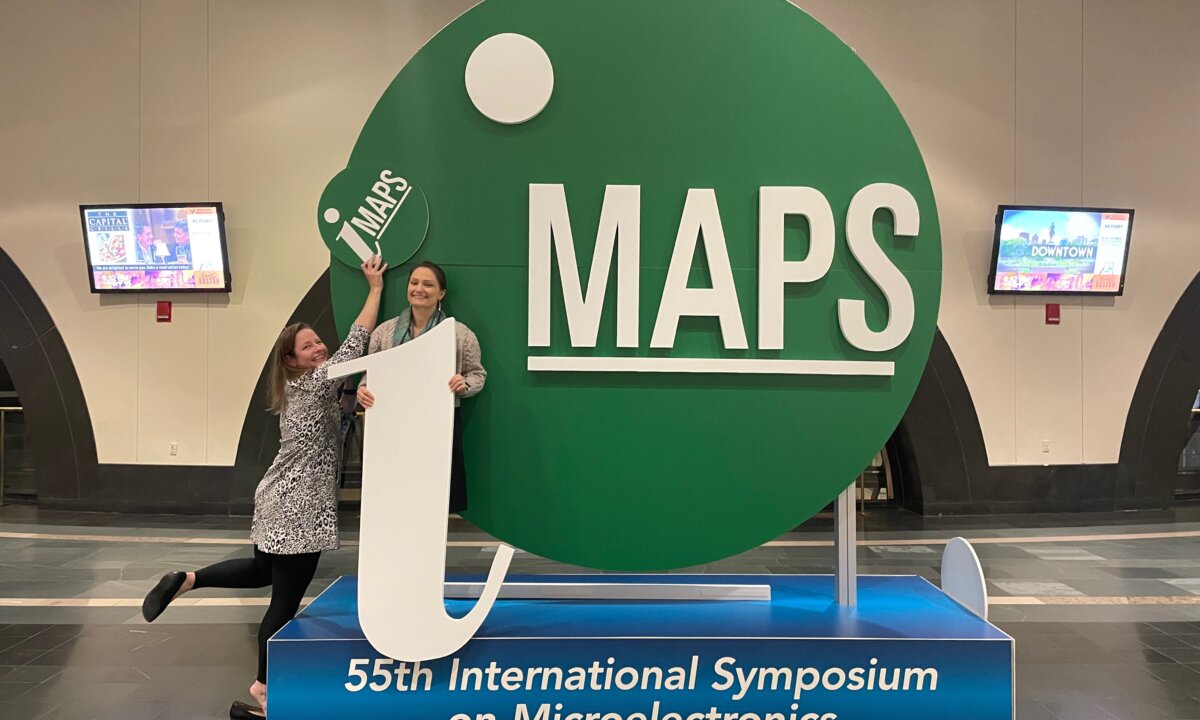One of the things I love most about being part of the International Microelectronics and Packaging Society (IMAPS) is the spirit of community this organization has cultivated over the years. It’s one of the reasons there is so much synergy between IMAPS and 3D InCites, and why we have become official industry partners. Many of our members overlap, and together we can offer them more: a technical society (IMAPS) and a content platform (3D InCites).
If you read Trine Pierik’s IMAPS preview, you’ll see that 25 of our members participated in this year’s symposium. Before I dive into key takeaways from last week’s IMAPS International Symposium, I’d like to share a little story that illustrates what I mean.
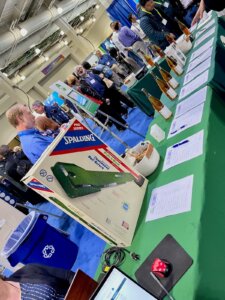
Each year, IMAPS hosts a Silent Auction to benefit the IMAPS Foundation, which supports student activities related to the study of Microelectronic Packaging, Interconnect, and Assembly. I perused this year’s offerings, and have recently taken up golf, decided to bid on a portable putting green (left). What I didn’t give much thought to was how I was going to get it home to Arizona if I won it, which I did (right).
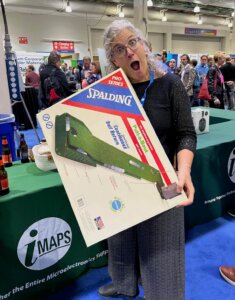
The FedEx office in the hotel was closed for the day, and I had an early morning flight. I also had a lot to transport home on my own, even though Keith Cooper, NXQ, had already helped me deal with getting my booth shipped back (He helped me schlepp it to the FedEx office and I am eternally grateful).
In addition to my checked bag, I still had my podcast equipment and laptop as carry-ons. It was going to be tricky. But Craig North, Gel-Pak; and Garrett Oaks, EV Group; engineered a handle out of packing tape so I could carry the box and check it at the airport. Problem solved.
But as I was walking back from dinner through the Prudential Center, I noticed a 24- hour Post Office, and I thought how much easier (and cheaper!) it would be just to mail it home. So I went back to my room, grabbed the box, and returned to the Post Office (By now it was about 10 pm). Turns out the box was too big for the self-serve mailbox, so I purchased the postage and went back to the hotel to see if I could leave it for the postal carrier to pick up. I couldn’t. Back to Plan A.
Walking through the hotel with my new prize, I stopped to chat with Casey Krawiec, StratEdge and shared my plight. Since he wasn’t leaving for another day, he generously offered to drop off my box at the Post Office for me, which he did. And wouldn’t you know – the box showed up in-tact at my doorstep early Sunday morning. THIS is what communities do for each other! Thank you all!
On to the Show…
While many of us have been attending live, in-person events for about a year now, almost everyone I spoke with at this year’s IMAPs International Symposium remarked how we were finally back to the pre-COVID conference experience. That meant a jam-packed keynote and paper line-up; a busy exhibitor floor, a few planned outings, and many more opportunities for catching up and connecting with colleagues. And everyone I spoke with was pretty excited about it. I was actually surprised that for some attendees, this was their first live event since the lockdown in March 2020.
I personally conducted 13 podcast interviews with keynote speakers and 3D InCites members; and recorded the DEI Town Hall in its entirety. That means we’ll have some interesting, high-energy episodes dropping over the next few weeks! In the meantime, here are some of my overall impressions of Monday’s DEI Event and Lionel Kimmerling’s keynote.
The Difference between Equity and Equality
The DEI Town Hall was sponsored by Honeywell Federal Manufacturing & Technologies (also a 3D InCites community member. Despite its less than favorable time slot on the agenda (7-8pm, Monday), it drew a very respectable crowd – 38 total. And more importantly, 27 of those were men. It was a pleasant change from years past! I applaud those who were curious enough about the topic: The Difference between Equality and Equity to attend.
Deca’s Robin Davis organized a distinguished panel of industry veterans who shared their perceptions and personal stories, including Jean Trewhella, GlobalFoundries; Susan Trulli, Raytheon; Urmi Ray, Saras Microdevices; Shelby Nelson, Mosaic Microsystems; and KT Moore, Cadence.
Davis provided a framework for the conversation, explaining the difference between Equal and Equity: Equality means each employee gets the same bicycle to ride, and equity means that everyone gets the bicycle that suits their needs (Example below). The panelists then also offered tips for how to overcome our own unconscious bias to create a culture of DEI at our own workplaces.
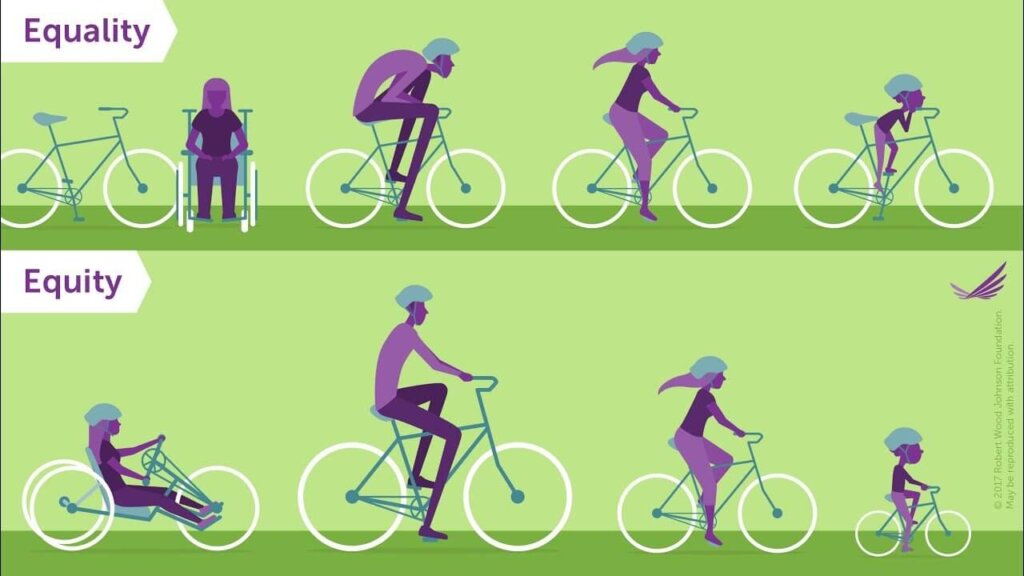
For me, the most pivotal moment of the conversation came via a comment from attendee Douglas La Tulipe, of Draper Labs. As Moore was sharing an example of when he experienced unconscious bias, describing a time when he felt inclined to prove his capability by essentially speaking his resume to the room; La Tulipe commented that if he were in the same situation, he would never do that. He asked why Moore had, and Moore responded directly: “Because of imposter syndrome”. And then he explained how women and underrepresented minorities often must be twice as qualified as their white male counterparts to receive the same recognition for their work. Over time, this results in us questioning our own credibility, and thus we feel like imposters.
I so appreciated La Tulipe’s question, because it illustrated clearly how if you’ve never experienced this kind of prejudice, you may not be aware that it exists. It sparked a very interesting discussion between him and the panelists.
If you’re wishing you hadn’t missed the discussion, you’ll be happy to know we’re broadcasting a recording of it on the 3D InCites Podcast on October 27.
Co-Packaged Optics Demystified
I must admit that for quite some time, I’ve shied away from the talks on silicon photonics and co-package optics because it really hasn’t been our area of coverage. But after listening to the keynote by Lionel Kimmerling, Thomas Lord Professor of Materials Science and Engineering Director at MIT Microphotonics Center, I realize that there is no more avoiding it. Kimmerling spoke on the topic of electronic-photonic package integration, which he says will be the next big technology transition in the IC field, particularly when it comes to chip stacking.
Kimmerling explained that the massive amount of data being processed and transmitted needs solutions in the system that brings chips together while controlling latency. This is particularly important in applications such as telepresence, which require simultaneous delivery of video and audio, for example, to simulate a live experience in 3D.
Bringing silicon photonics into the package flow helps because scaling in the spectral domain allows for improved bandwidth density. “Distance is unlimited for photonics in comparison with copper, “explained Kimmerling. “The Chip Era has Ended – The SiP era is in full implementation and photonics has to be part of it to handle the interconnect challenge.”
However, despite the fact that the first full Si photonics package flow was developed in 2005, electronic-photonic package integration has challenges to overcome before it is commercialized. Essentially, it needs to be comparable in cost to copper interconnect, and everything developed has to work with what already exists to be adopted.
How do we turn what we have into a photonics platform? Materials are one issue. For example, melting solder could damage the optical chips. We need organic solutions, said Kimmerling. He predicted that in five years, Cu and photonics will coexist in a ratio of 90%/1%. 3D chip technology will become compatible.
After his keynote, I interviewed Kimmerling and his colleague, Anu Agerwal, MIT – Director of Electric Photonics, and principal research scientist. This conversation kicks off the keynote spotlight podcast episode that we’ll be dropping Thursday.
The Promise of 6G, and Edge Computing
NXP’s Glenn Dave’s very informative talk on the promise of 6G had me wondering why we’re not just skipping over 5G to get to the capabilities of 6G. To hear the answers to all my 6G-related questions, you’ll have to tune into the podcast episode! David Bolognia’s keynote on Advanced Medical Devices at the Intelligent Edge also provided some great questions for our podcast interview.
Member Spotlights
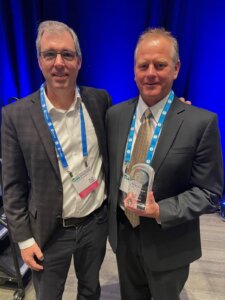
Lastly, I’d like to recognize two of our members who received significant recognition from IMAPS: Congratulations to ASE’s Bill Chen, co-chair of the IEEE Heterogeneous Integration Roadmap who was presented with the Daniel C. Hughes Jr. Memorial Lifetime Achievement Award for his leadership and contributions. Congratulations also to Deca’s Tim Olson (right), who received the Founder’s Award.
Next week’s podcast episode will feature a conversation with Tim, as well as other members including Craig North, Gel-Pak; Bill Acito, Cadence; Bob Connor, X-Celeprint; Finetech’s new CEO, Carlotta Baumann; Casey Krawiec and Tim Going of StratEdge; QP Technologies’ Dick Otte; and Keith Best, of Onto Innovation. There’s also an exclusively sponsored podcast episode with Szi Pei Lim and Dean Payne, of Indium Corporation, on the topic of pressure silver sintering. Like I always say, stay tuned, there’s lots more to come, on the 3D InCites Podcast.



